How to Grow Blue Dream Strain
Blue Dream, a hybrid strain with a rich lineage, is a sought-after choice for both novice and experienced cannabis cultivators. Its unique blend of flavors and effects make it a standout. This guide delves into the intricacies of growing Blue Dream, ensuring even beginners can achieve a successful harvest.
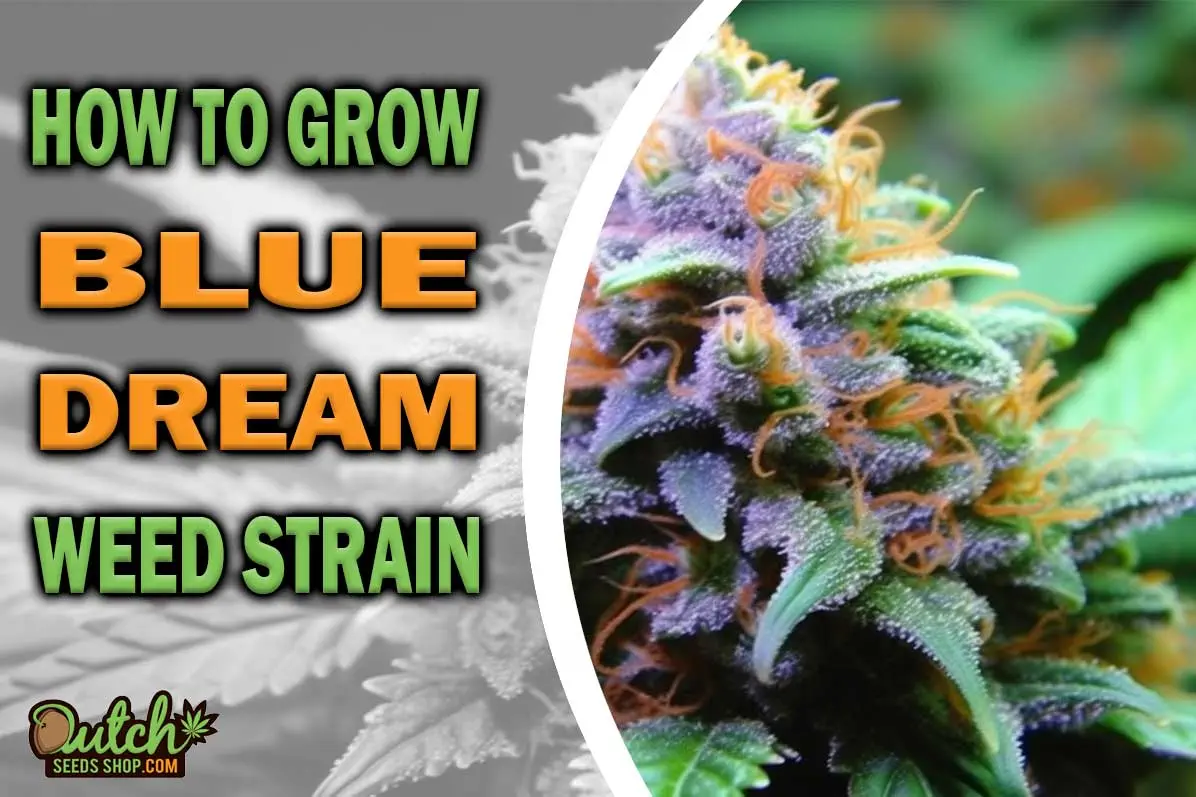
Get To Know Blue Dream Strain
Blue Dream originated from the cross-breeding of Blueberry and Haze, inheriting a tantalizing aroma and a blend of effects that spark creativity and provide energy.
It’s a 60% sativa-dominant hybrid, boasting THC levels between 16% and 20%, and minimal CBD content below 0.2%.
Noted for its easy indoor growing and intermediate outdoor difficulty, Blue Dream thrives in a mild climate and has a medium height.
Its flowering time ranges from 56 to 70 days, with indoor yields of 1.3 to 2 oz/ft² and outdoor yields of 14 to 21 oz per plant.
The strain’s terpene profile includes Caryophyllene, Myrcene, and Pinene, contributing to its resistance against pests and diseases but vulnerability to spider mites and mildew.
Enthusiasts praise Blue Dream for its sweet, berry-like flavors and balanced effects, perfect for relieving symptoms like nausea and pain.
| Aspect | Details |
| Lineage | Blueberry x Haze |
| THC/CBD Content | 16%-20% THC, <0.2% CBD |
| Flavors | Blueberry, Berry, Earthy, Sweet |
| Effects | Happy, Energetic, Creative, Balanced |
| Grow Difficulty | Easy (Indoor), Intermediate (Outdoor) |
| Flowering Time | 56-70 Days |
| Yield | Indoor: 1.3-2 oz/ft², Outdoor: 14-21 oz/plant |
Tips and Tricks for Growing Blue Dream Successfully
Growing Blue Dream feminized seeds starts with understanding its growth stages and requirements.
Beginners should focus on indoor cultivation, as it’s easier and less prone to pest issues.
For successful growth, consider the following:
- Selecting Seeds or Clones: Choose high-quality seeds or clones to ensure a healthy start.
- Cultivation Techniques: Employ training methods like topping or LST (Low-Stress Training) to control plant size and enhance yield.
- Flowering Time: Expect a flowering period of 56 to 70 days; adjust your lighting schedule accordingly.
- Nutrient Solutions: Use balanced nutrient solutions tailored for cannabis during different growth stages.
Blue Dream Indoor Growing
Indoor cultivation of the Blue Dream strain presents a unique set of advantages and challenges.
Known for its vibrant aroma and potent effects, Blue Dream thrives in controlled environments.
Growing it indoors allows cultivators to fine-tune conditions, ensuring optimal growth and yield.
However, it requires attention to detail in terms of climate control, lighting, and space management.
Benefits of Indoor Growing
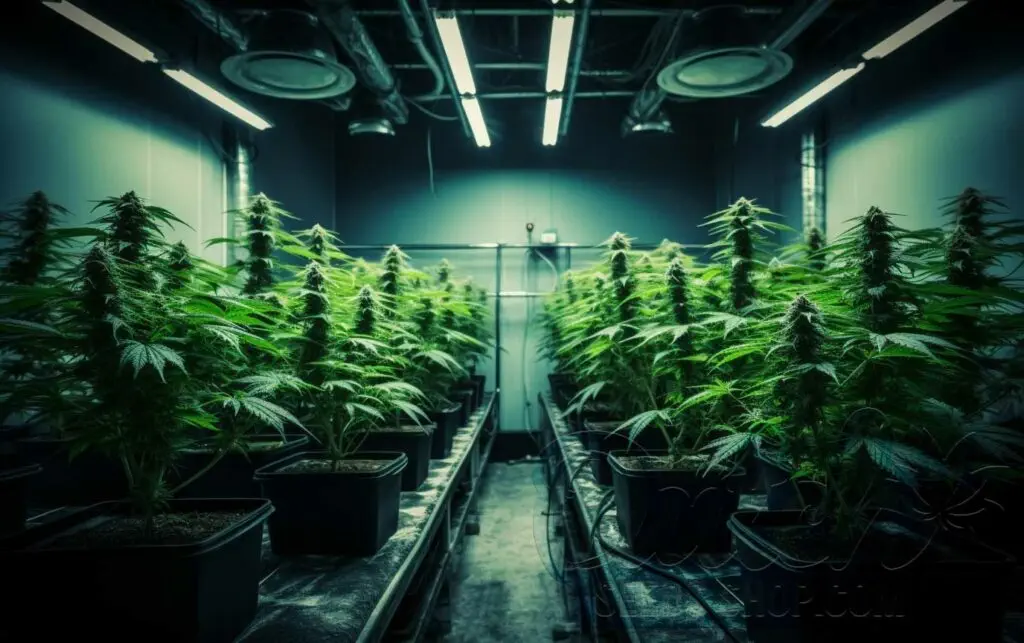
Indoor cultivation of Blue Dream offers numerous benefits.
The controlled environment leads to high-quality cannabis, with vibrant flavors and potent effects.
Indoor growers can manipulate conditions to optimize growth and yield, leading to superior product quality.
Multiple harvests are possible throughout the year, regardless of external weather conditions.
Indoor growing also provides enhanced privacy and security, crucial for growers in areas with restrictive cannabis laws.
Real-life examples include growers who have consistently produced award-winning Blue Dream strains under indoor conditions, showcasing the strain’s potential in a well-managed environment.
- High-quality cannabis production
- Control over environmental factors
- Multiple harvests per year
- Enhanced privacy and security
Setting Up Your Indoor Grow Space
To grow Blue Dream indoors, begin by selecting an appropriate space.
A closet, tent, or spare room can serve as an efficient grow area.
Ensure proper ventilation to manage temperature and humidity, while controlling odor.
Various grow lights, including HID, fluorescent, and LED, play crucial roles in different growth stages.
Cost management is also vital; starting small and scaling up as you gain experience can help manage expenses.
Adequate head space is essential for plant growth, especially for taller strains like Blue Dream.
- Choose an appropriate space (closet, tent, spare room).
- Ensure proper ventilation for temperature and humidity control.
- Select suitable grow lights (HID, fluorescent, LED).
- Manage costs by starting small.
- Provide enough head space for plant growth.
Climate Control
Optimal climate control is critical for growing Blue Dream indoors.
Temperature, humidity, and light intensity must be carefully monitored and regulated.
Environmental controllers automate these processes, ensuring stable conditions.
Air-cooled reflector hoods are beneficial for HID lights, reducing heat.
Oscillating fans improve air circulation, promoting healthy plant growth.
Tools like dehumidifiers and air conditioners help manage humidity levels.
Timers and environmental controllers can automate these processes, maintaining ideal conditions for Blue Dream.
Types of Lights
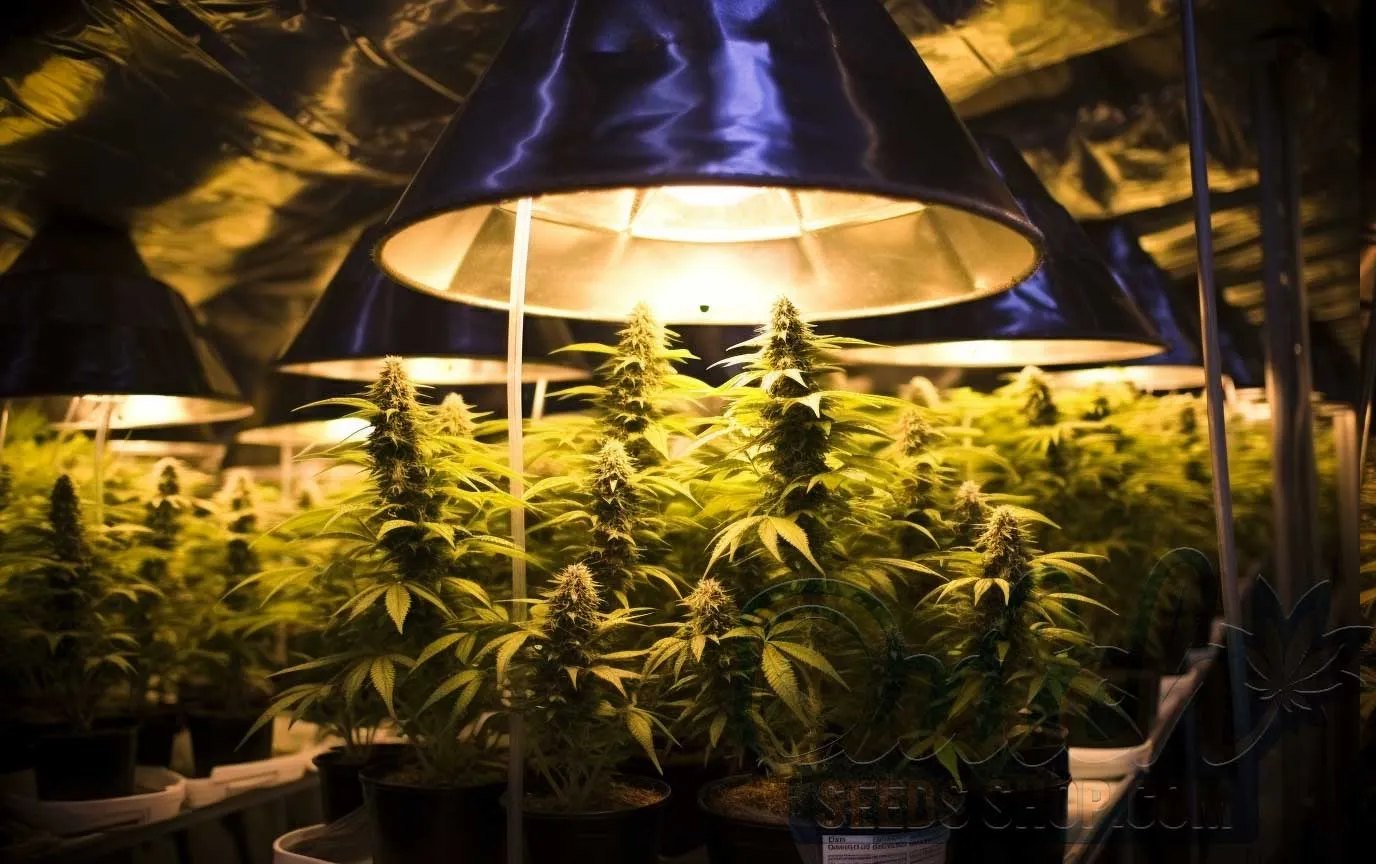
The choice of grow lights significantly impacts Blue Dream’s growth.
HID lights, including MH for vegetative growth and HPS for flowering, are effective but energy-intensive.
Fluorescent lights are ideal for small-scale growers due to their lower energy consumption.
LED lights are the most energy-efficient and provide a full light spectrum, beneficial for all growth stages of Blue Dream.
Each light type influences the plant’s development, from vegetative growth to flowering.
- HID lights for vegetative and flowering stages
- Fluorescent lights for small-scale operations
- Energy-efficient LED lights
Growing Mediums and Containers
For Blue Dream, growers can choose between soil and hydroponics.
Soil is traditional and forgiving, suitable for beginners.
Hydroponics, on the other hand, offers faster growth and potentially higher yields but requires more expertise.
When selecting containers, standard plastic pots are budget-friendly but may impact root health.
Fabric containers promote better airflow and healthier root systems.
Ensuring proper drainage is critical to prevent root rot and maintain plant health.
Caring for Indoor-Grown Blue Dream
Regular care is vital for indoor-grown Blue Dream.
Monitor your plants daily, especially in the early stages, for signs of environmental stress.
Adjust temperature, humidity, and light levels as necessary.
Regular watering with clean, pH-balanced water is essential.
Nutrient levels should be closely monitored, with supplements added as required.
Pruning and removing dead leaves help maintain plant health and size.
Odor Control
Odor control is a significant aspect of growing Blue Dream indoors.
Maintaining appropriate temperature and humidity levels minimizes odors.
Proper air circulation, achieved through exhaust and intake fans, is crucial.
Odor-absorbing gels can mask smells, while activated carbon filters are effective for odor removal.
These methods ensure a discreet cultivation process, crucial for indoor growers concerned about privacy and compliance with local regulations.
Blue Dream Outdoor Growing
Outdoor cultivation of Blue Dream opens a different realm of possibilities compared to indoor growing.
Embracing the natural elements, this approach can yield significant benefits but also presents unique challenges.
Understanding these nuances is key to harnessing the full potential of Blue Dream in an outdoor environment.
Benefits of Outdoor Growing
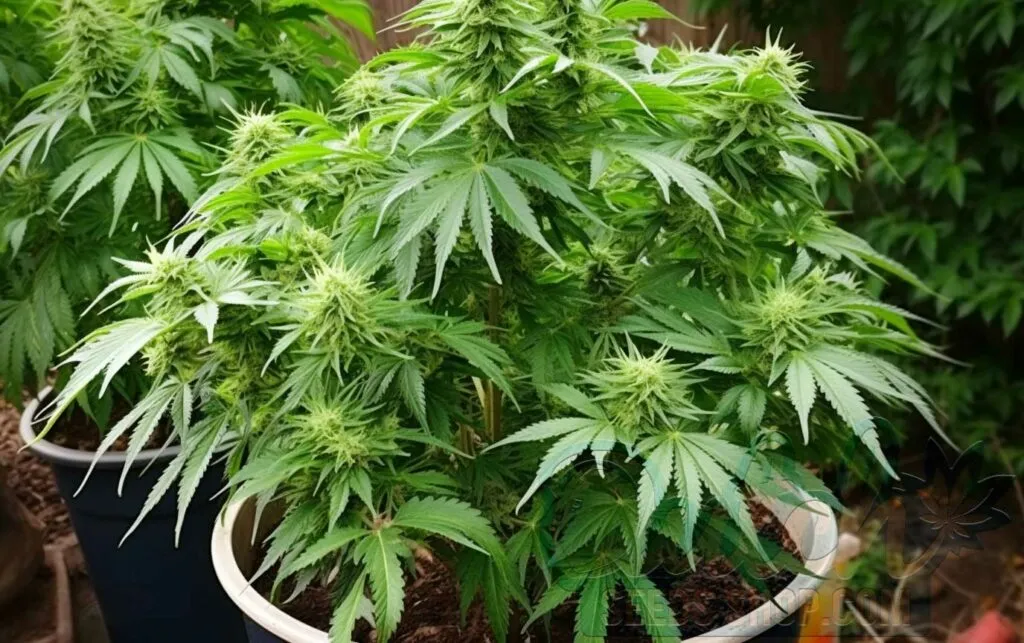
Growing Blue Dream outdoors offers distinct advantages.
The natural sunlight and larger space allow for bigger plants and, consequently, larger yields.
This method is more cost-effective, eliminating the need for expensive indoor lighting and climate control systems.
Outdoor cultivation is environmentally sustainable, utilizing natural resources like sunlight and rainwater.
Moreover, gardening outdoors has therapeutic benefits, providing a relaxing and fulfilling experience for growers.
These advantages make outdoor cultivation an appealing option for many cannabis enthusiasts.
| Advantage | Details |
| Larger Yields | Natural sunlight encourages bigger plant growth. |
| Cost-Effectiveness | Reduced need for artificial lighting and climate control. |
| Sustainability | Utilizes natural resources efficiently. |
| Therapeutic | Offers a fulfilling gardening experience. |
Best Time to Plant Blue Dream Outdoors
For optimal results, plant Blue Dream outdoors in late spring.
This timing varies based on regional climate; in the Northern Hemisphere, April or May is generally ideal.
Start the germination process indoors to protect the seedlings from extreme weather.
Gradually acclimatize the plants to outdoor conditions before transplanting.
This approach ensures a strong start for the plants, vital for healthy growth and bountiful harvest.
Setting Up Outdoor Grow Spaces
Establishing an effective outdoor grow space for Blue Dream requires careful consideration of several factors:
- Understand the local climate, including temperature ranges and weather patterns.
- Choose a location that receives ample sunlight, ideally at least 6 hours per day.
- Protect plants from wind using natural windbreaks or artificial barriers.
- Consider privacy and security, especially in regions with restrictive cannabis laws.
- Select the type of grow space – garden plot, balcony, or rooftop, based on available space and conditions.
Selecting and Preparing Soil
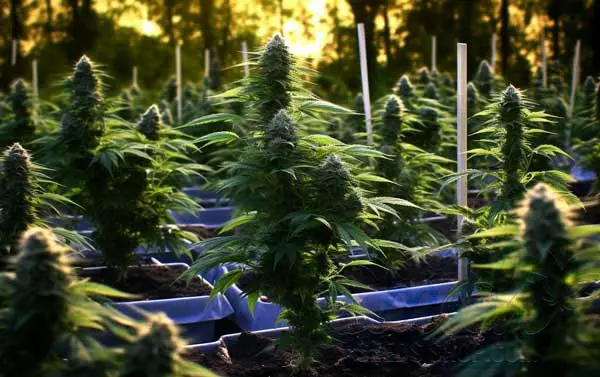
Soil selection and preparation are crucial for outdoor Blue Dream cultivation.
Test the soil to understand its composition – clay, sand, silt – and pH level.
Amend the soil based on these results to create an ideal growing environment.
Opt for organic matter-rich soil, ensuring it is well-draining to prevent waterlogging.
If natural soil isn’t suitable, consider using quality potting soil or pre-fertilized “super-soil” for ease of cultivation and optimal nutrient balance.
Nutrients and Fertilizers
Effective nutrient management is key for thriving outdoor Blue Dream plants.
The balance of nitrogen, phosphorus, and potassium is crucial throughout the plant’s life cycle.
- Organic fertilizers like blood meal or bone meal are preferable for their natural composition and gradual nutrient release.
- Synthetic fertilizers are available but should be used cautiously to avoid over-fertilization.
- Irrigation should be managed to maintain optimal soil moisture without waterlogging.
- Regularly monitor nutrient levels and adjust the feeding schedule as the plant progresses through different growth stages.
How to Maximize Blue Dream Yield
To maximize the yield of Blue Dream strain, both in indoor and outdoor settings, implement advanced cultivation techniques.
Training methods such as topping or Low-Stress Training (LST) can significantly enhance plant health and yield.
In outdoor settings, optimizing light intensity through strategic plant placement and using CO2 enrichment methods can further boost growth and yield.
These practices require a higher level of cultivation expertise but can lead to significantly higher yields and superior quality cannabis.
Mastering the cultivation of Blue Dream is a rewarding journey, blending the art and science of cannabis growing.
This strain, with its unique blend of flavors and effects, offers cultivators the chance to experience high-quality yields.
Indoor growers can appreciate the control over environmental factors, while outdoor cultivators enjoy the natural benefits and larger yields.
Blue Dream is versatile, adapting well to different growing conditions and techniques, making it a suitable choice for both beginners and experienced growers.
The effort invested in growing Blue Dream pays off in its potent, balanced effects and its capability to provide relief for various symptoms.
Embracing the challenge of growing Blue Dream leads to not only a bountiful harvest but also a deeper understanding and appreciation of cannabis cultivation.
FAQs
How does the Blue Dream strain respond to different pH levels?
Blue Dream prefers a soil pH between 6.0 and 7.0. In hydroponic setups, aim for a pH of 5.5 to 6.5. Proper pH balance is crucial for nutrient uptake and overall plant health.
Can Blue Dream be grown in colder climates?
While Blue Dream thrives in mild climates, it can tolerate cooler temperatures.
What are the common pests and diseases to watch out for with Blue Dream?
Blue Dream is resistant to mold and mildew but can be susceptible to spider mites and root rot.
How much space is required between Blue Dream plants in an outdoor setup?
Space Blue Dream plants at least 2 feet apart outdoors.
What are the signs of a successful harvest of Blue Dream?
Blue Dream is ready to harvest when most trichomes turn cloudy white with some amber ones. The pistils should also darken and curl.
About the Author
Share the Love:
